 |
||
|
||
| ||
We continue to consider the latest video cards, in particular cards based on GPU GeForce2 Pro. Today we will take a look at a card based on GeForce2 Pro from Innovision company - Inno3D Tornado GeForce2 Pro. The company Innovision Multimedia is well known thoughout the world and it makes no sense to introduce it here. Let's directly turn to the subject. BoardInno3D Tornado GeForce2 Pro specifications:
Here the card itself:  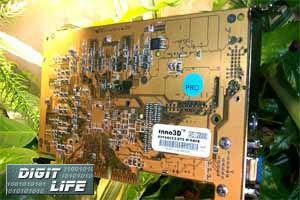 The card is equipped with AGP2x/4x interface, 64 MBytes 5 ns DDR SDRAM located in 8 chips on the right side of PCB:  Memory chips ESMT are produced by EliteMT company and intended for 200 (400) MHz working frequency. Note that sometimes specifications contain only effective clock speed of DDR memory, which are two times more. That is, if you read that DDR-memory frequency is 400 MHz, in fact it works at 200 MHz. The card is equipped with a standard active cooler with a bunch of both advantages and disadvantages. As for its highs, there are a large number of blades on the fan and many fins on the radiator. They undoubtedly provide much better cooling. On the other hand, the cooler is not mounted on a bracing but glued to the chip, what does not ensure absence of air cushions between the cooler and the chip. The cooler lacks of a tachometer. It's easy to notice that Innovision used a reference design from NVIDIA when developing their card. The PCB is rich yellow. It's equipped with a daughter card with a TV-out (Conexant BT869 chipset). Besides, the video card provides a blank space for a jack for digital monitors. Unfortunately, the complete set doesn't include a S-Video-to-RCA adapter. The card sells in a box of a usual Innovision design that differs from GeForce2 GTS box in stickers "Pro" below and "64MB" above: 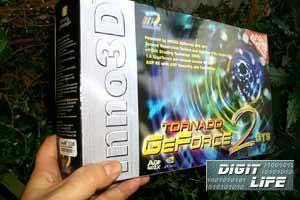 Here is the complete set itself which is as usual quite rich:
OverclockingWith this card we managed to overclock the graphics core up to 220 MHz, and the memory worked at as high as 480 MHz of resulting frequency (!). Installation and driversNow when we are through with the theory let's pass to tests. As usual we start with our testbed:
The card was supplied with a driver based on NVIDIA reference driver 5.33. Since it is an aging version of software we used drivers' version 6.47 from NVIDIA. Test resultsAs for 2D-graphics, I should notice that it just slightly differs in quality from the boards of this class that were already considered. It means that quality of 2D takes an upper level. Well, I must say again that 2D-graphics of exactly this card from Innovision Multimedia rouses no censure (there tells upon complete following the reference design from NVIDIA). Video cards of such class satisfy the most users with quality images. The following two games will help us to consider performance of Inno3D Tornado GeForce2 Pro in 3D-graphics:
With these tools we will show you the video card performance via two main API. Beside this card, there are diagrams for three other video cards: Creative 3D Blaster Annihilator2 Ultra based on GeForce2 Ultra (as the fastest accelerator for now), Leadtek WinFast GeForce2 Pro and ASUS AGP-V7700 Pro on GeForce2 Pro. Then, you may see the performance gain of Inno3D Tornado GeForce2 Pro in overclocking mode. 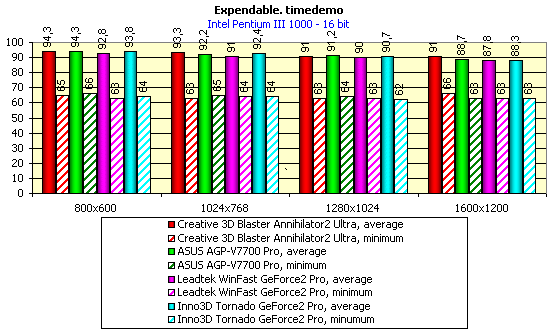 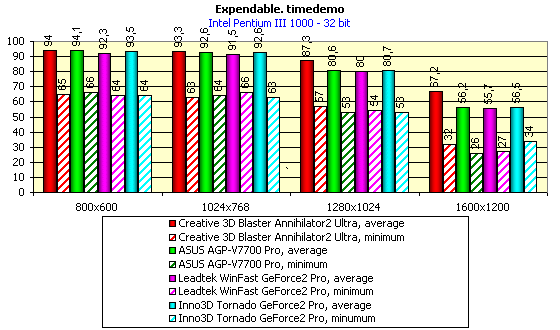 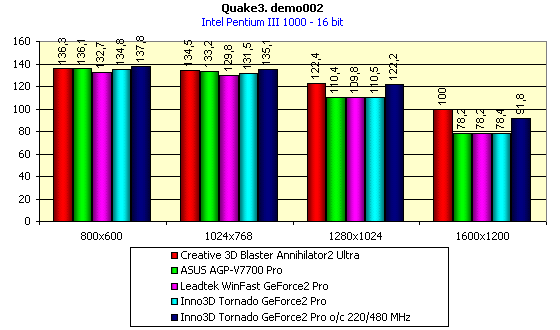 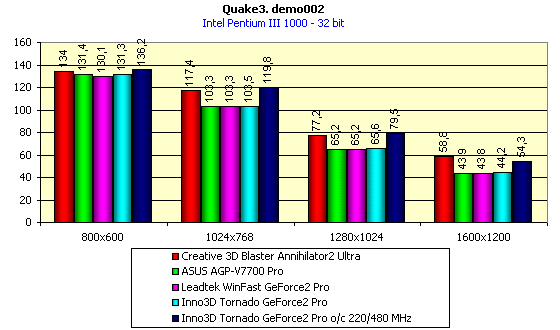 It's easy to notice that in 16-bit color in Expendable the boards on GeForce2 Pro do not differ much from more expensive brothers on GeForce2 Ultra since the speed of both cards is limited by the performance of CPU of the system. Only in Quake3 you can see some decrease in the speed with resolution going up, however all three cards on GeForce2 Pro give out identical results. Interestingly that there are not so much difference in 32-bit color between cards on GeForce2 Pro overclocked and GeForce2 Ultra. It's very important especially considering that GeForce2 Ultra based cards cost much more. In general, the performance results of the video card Inno3D Tornado GeForce2 Pro are quite high and should be satisfactory for the most exacting gamers. Note that the card from Innovision worked with minimum additional cooling while at irregular frequencies (in overclocking mode) - there was only one additional fan in the case. ConclusionWell, the card Inno3D Tornado GeForce2 Pro showed perfect results in performance. Its gameability has nothing to accuse it of at practically all resolutions. Besides, a customer saves money when buying GeForce2 Pro based card as comparing with a board on GeForce2 Ultra. As experience shows, memory installed on such boards has a good potential as far as overclocking is concerned (at irregular frequencies). And this allows to achieve performance gain at the level of GeForce2 Ultra based cards when working at irregular frequencies. In general, the Inno3D Tornado GeForce2 Pro card is a bright specimen of GPU family of the second generation from NVIDIA and takes a leading position considering "price/performance" ratio among all the fastest 3D accelerators in its class. Pros:
Cons:
Write a comment below. No registration needed!
|
Platform · Video · Multimedia · Mobile · Other || About us & Privacy policy · Twitter · Facebook Copyright © Byrds Research & Publishing, Ltd., 1997–2011. All rights reserved. |